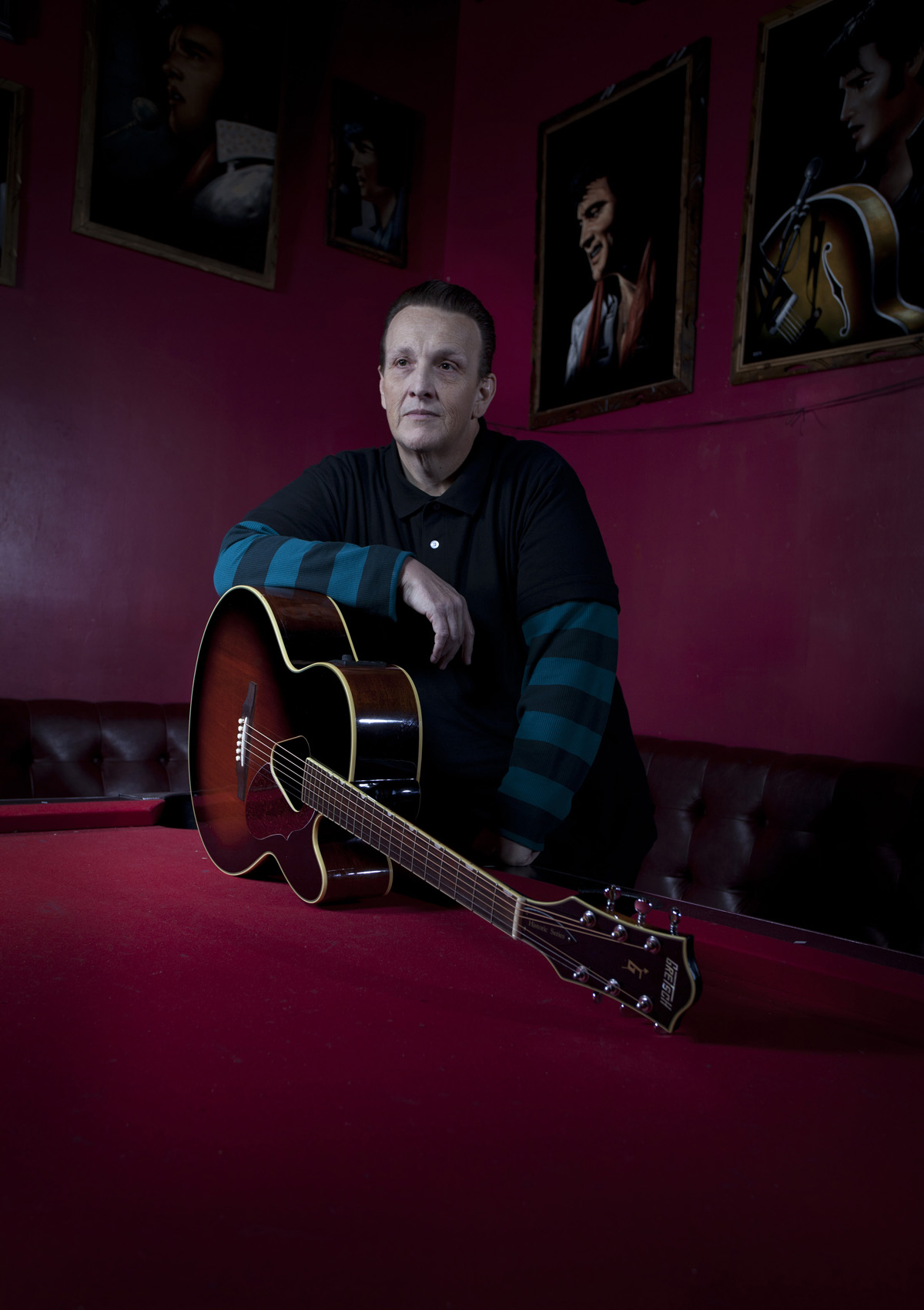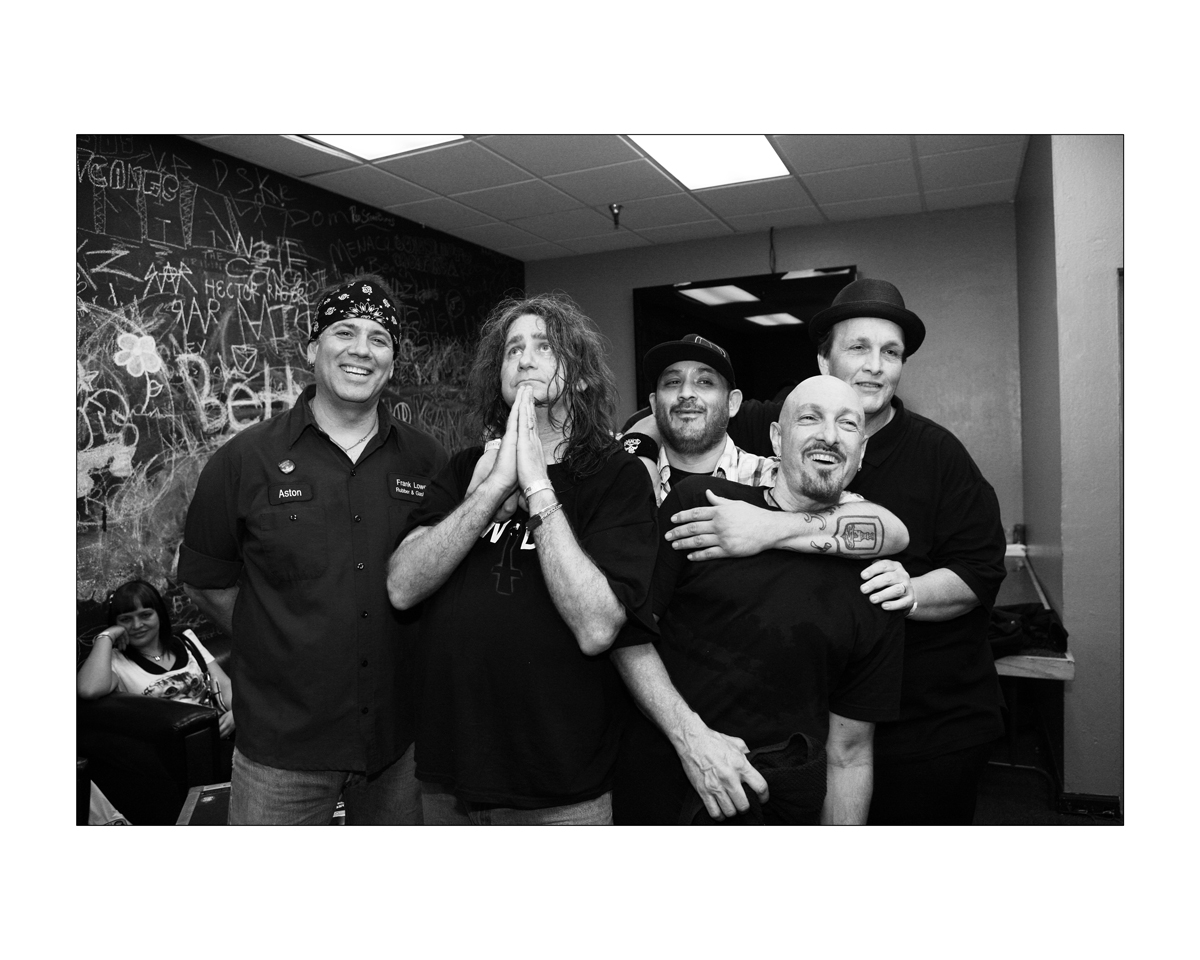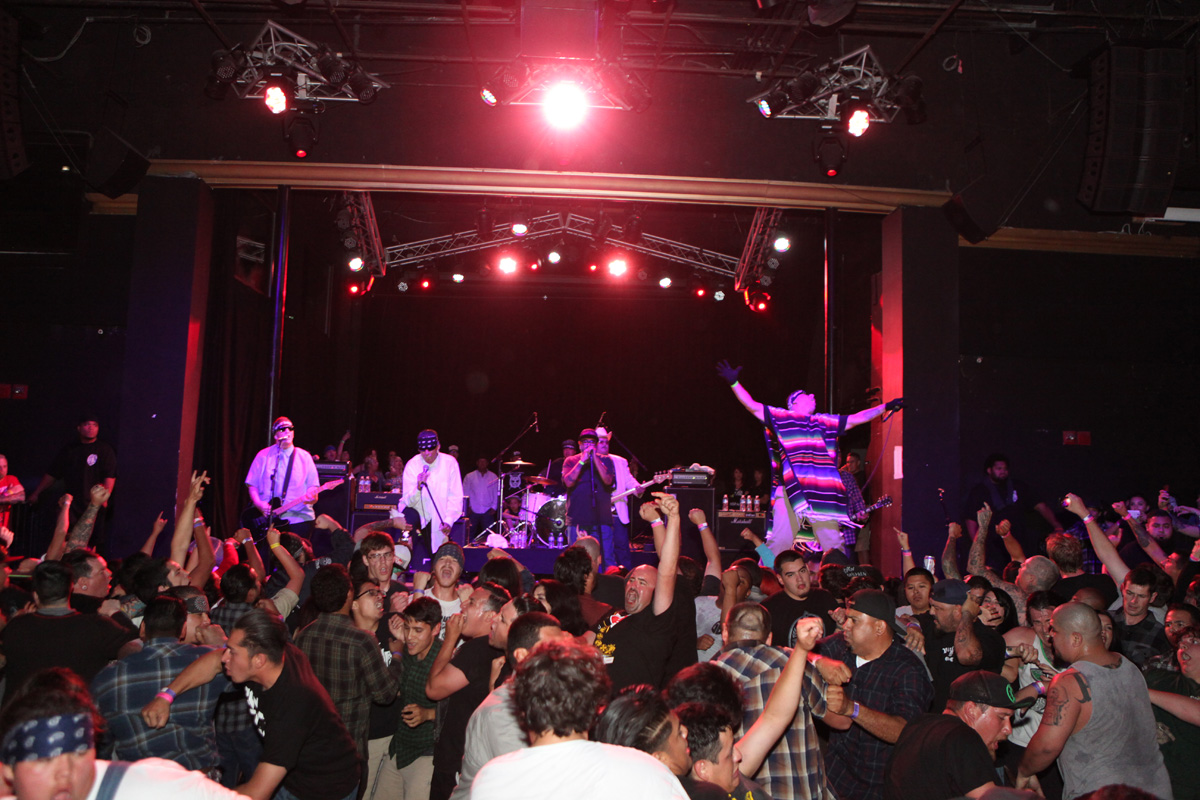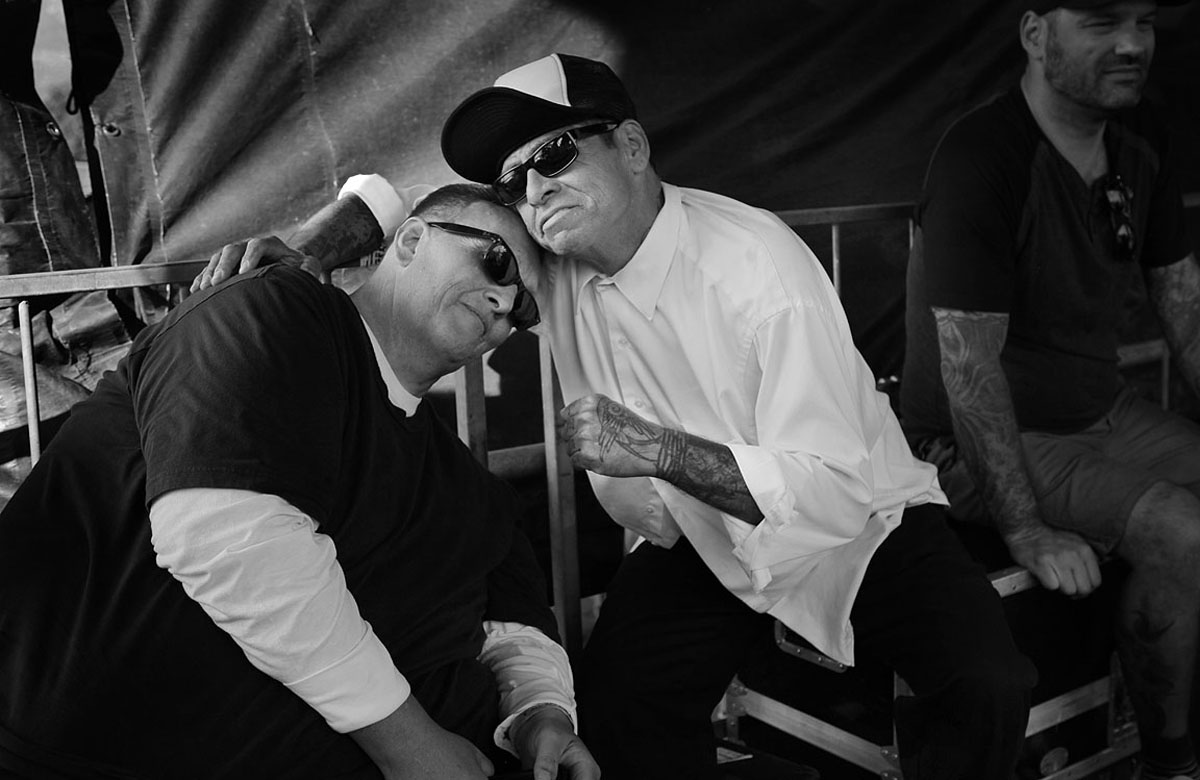
There’s a phrase that followed Steve Soto until the day he died: “The Nicest Guy in Punk Rock.” On the surface, it sounds appropriate, even pleasant. After all, everyone likes a nice guy. However, for a figure who cast such a monumental shadow over Orange County punk, nice is too small of a word. Nice doesn’t produce dozens of albums and tour the world with multiple bands. Nice is not cavalier. Nice doesn’t refuse to let obstacles stand in its way. Nice has no business being in the Black Hole. Nice couldn’t match wits with Gabby Gaborno. Nice doesn’t fill the church at a funeral. Yes, Steve Soto, was a nice guy—among many things—but an easy phrase, however affectionate, couldn’t capture an ounce of his legend.
Nicknames, however, are the stuff of truth—simple, effective, intimate and everlasting. Since he was a teenager, Soto had one that stuck: “Hokey.”
Back in the fall of 1980, Soto sat between Frank Agnew of the Adolescents and Scott Miller, the drummer for Agent Orange, in the Stanton apartment of Frank’s brother and fellow Adolescent guitarist Rikk Agnew. Rikk had just presented a new song he’d written, a little punk opus he called “Kids of the Black Hole”—an ode to the infamous drug-addled crash pad once inhabited by Mike Ness from Social Distortion.
“I remember Soto saying, ‘This is it; this is the song that’s gonna put us above every other band,’” Frank remembers. At the time, no one had heard a smartly crafted punk tune with layered guitar melodies and seedy, poetic lyrics of suburban angst and a catchy chorus—or a song that lasted a whole five and a half minutes. It felt like the punk equivalent of the Who’s “Quadrophenia.”
Elated with his creation, Rikk went into his bedroom with his girlfriend at the time to celebrate, leaving Soto and his chums passing around a jug of Carlo Rossi wine in the living room.
As they drank, Miller bragged about all the big opportunities Agent Orange had coming up, visibly annoying Soto, whom they’d kicked out of the band months before, a move that spurred him to start the Adolescents. As his veins coursed with cheap cabernet courage, the hefty teenage punker decided he’d had enough. “You know what, Miller?” Soto said. “I gotta tell you something: Fuck Agent Orange! Let’s compare Adolescents to Agent Orange. No. 1, you’re a shitty drummer, Casey [Royer] is way better than you. No. 2, I’m a 10 times better bassist than [James] Levesque—you kicked me out for that fucker?! And let’s go to guitar: the Agnew brothers against Mike Palm? Ha! And singers? Palm’s boring, Tony [Reflex] is exciting. And we got better songs!”
“He was going on and on about how shitty their band was and how great they were,” Frank says, smiling at the memory with boyhood glee.
During the drunken browbeating, Miller stayed quiet, but his face was red-hot. “So the bottom line,” Soto said, “is that you’re shit, we’re great, and I gotta go take a piss!” He got up to walk to the bathroom and immediately collapsed, hammered from the wine like a nail in a floorboard.
Miller got up from the couch and put his face right in front of Soto and delivered a dramatic, solitary come back: “Steve . . . you play HOKEY bass!”
Soto paused, momentarily stunned, then started laughing heartily. “I play hokey bass!” he parroted, shaking his fists.
“He’s been Hokey ever since,” Frank says.
Decades later, no matter where he traveled or how far he took his music, when people called him Hokey, Soto knew he was home.
On June 27, Soto died at the age of 54. A few days after the Adolescents’ last East Coast tour, he went quietly in his sleep in the house he grew up in on a cul-de-sac in an upper-middle-class neighborhood in Placentia. The night before, he’d recorded songs with longtime friend and Joyride band mate Greg Antista and producer Jim Monroe, who recorded many of Soto’s finest albums for Doctor Dream Records.
His death appeared to be the result of his decades-long struggle with poor health, a battle with his weight and congestive heart failure. Soto’s passing sent shockwaves through the music world, inspiring stars such as Billie Joe Armstrong (Green Day), Noodles (The Offspring) and Travis Barker (blink-182) to pour out their sorrow on social media. It made headlines in Rolling Stone, Billboard, the New York Post and publications around the world—even FOX News covered it. But for those who really knew him, they lost not only an icon, but also a friend.
As a player and songwriter, he was unmatched. As a member of the Adolescents, Joyride, Manic Hispanic, 22 Jacks, Black Diamond Riders, the Twisted Hearts, Flock of Goo Goo and Punk Rock Karaoke, he was unstoppable. His talent far surpassed his physical stature. As an ambassador for OC punk, Soto’s impact was larger than life. “He only lived 54 years, which in the big picture isn’t a ton,” Agnew says. “But those 54 years were packed to the hilt, and he lived them exactly the way he wanted to. Someone could live to 90 years old and only live a third of what he lived.”
* * * * *

Just after sundown in Agnew’s Brea bungalow apartment, he and Antista are busy rehearsing some Soto classics to perform in honor of their friend during a memorial at Alex’s Bar in Long Beach. The two are in a special fraternity of early Fullerton punkers who knew Hokey best. They still get together to jam and play songs they wrote as youngsters in the band Joyride.
As they go over Soto’s tune “Forever,” Antista is both jealous and dumbfounded. “This one song has enough lyrics for three of my songs, and he probably knocked this out in 15 minutes,” he says, holding up the hand-scrawled lyrics sheet. “And it’s not like it was a second draft; he was like, ‘That’s it; I’m done—on to the next one.’”
Soto’s drive to make something of himself came from his darkest times. Early Adolescents songs are filled with angst, disillusionment and the pain of never “getting the girl.”
“If you’re dating a cheerleader . . . you’re not writing those songs,” Antista says. “None of us was, and that’s how we’re all connected. It was an outsider’s thing.”
Soto’s parents—father Jim and mother Sandy—moved to Placentia from Riverside with their three children when Steve was entering middle school. As a middle child with two sisters, Soto kept busy with baseball, basketball and running the streets until he started playing in bands. His dad, who incidentally shares the same Aug. 23 birthday as his son, brought home Soto’s first bass around 1977. Jim had plucked it out of the lost and found at his city job after it had sat for a year collecting dust. For avid young Beatles fan Steve, the McCartney-style Hofner violin bass was akin to destiny in his hands.
His obsession with the Fab Four started after a cousin dropped off a crate full of records at the Soto home. Steve used to listen to them while his mother cleaned the house. As were many kids, Soto was inspired to start a rock band called Lyte with his friends Mike Palm and Biddy; it morphed into Agent Orange once they discovered the four-chord fury of the Damned, the Ramones and the Clash.
Fullerton punkers were different from those in Huntington or Newport Beach. They weren’t surfers; they weren’t into cars or skateboards. They just played music.
At the height of punk, Soto and Frank Agnew remained unapologetic about their love for the classic music they grew up on and didn’t abandon it when their peers decided it wasn’t cool anymore. “We never sat there and acted like, ‘We’re punks, and we hate every other kind of music,’” says Agnew, who bonded with Soto over his love for the Beatles when he joined the Adolescents. “It just wasn’t like that.”
By ’79, several major punk bands had spawned in OC: the Mechanics, Social Distortion, Agent Orange, the Naughty Women and the Omlits, to name a few. They all hung out together at parties on weekends.
When they weren’t playing at the Cuckoo’s Nest or the Starwood, Soto and Frank Agnew could be found at these backyard shindigs fearlessly strumming old songs on acoustic guitar. “All these fuckin’ punkers with Mohawks and leather jackets who slashed themselves on the weekends and rolled in broken glass would all stop and listen to the Beatles,” Antista says. “Because it was just good music.”
Antista met Soto when he was 15, in drafting class during his first year at Troy High School. He remembers approaching the Adolescents bassist, who sported a leather jacket and spraypainted Orange Vans, wanting to hang out with him. “‘Hey, Steve Soto!’” Antista remembers greeting him. “[Steve] turns to me and goes, ‘You know what? I think you new punkers are lame.’” Antista laughs.
Despite a frosty introduction, the two eventually became friends in detention, and soon, Antista was part of the crew.
Soto already had a music career before graduating from Troy, thanks to the Adolescents’ self-titled debut, also known as The Blue Album. The original lineup with him, Frank Agnew and John O’Donovan on guitars; Peter Pan on drums; and Tony Reflex on vocals had shifted a bit when Frank’s brother Rikk replaced O’Donovan and brought with him some songs from his first band, the Detours.
The group was one big ball of characters, with Soto as the orchestrator. He didn’t sing on The Blue Album—that was mostly handled by Reflex, whose erratic behavior and lack of social graces as a kid made him an ideal punk front man whom Soto could mold. “Steve was the one person in my life who I never had an argument with,” Reflex says. “Here’s a person who knew me well enough, when to pull back and let me vent. He knew when to anticipate my behavior [in a way] that other people couldn’t anticipate and help me get myself in a place where I could write music in the first place. . . . I started as his student, and I became his peer.”
Soto was a source of encouragement, bringing the best out of his cohorts, an element of his upbringing and his religious faith. His Mexican father and Swedish mother were both Quakers. They were devout yet open minded about their son’s activities—even punk rock. “We didn’t know a whole lot about it, but he told me he liked it because it was fast,” Sandy says from the couch she shares with Jim. “I’m sure there were other things as well.”
Faded photos hang in frames on their walls, reminding them of Steve’s childhood and his beginnings with the Adolescents; a very dashing image of Soto wearing shades while hugging a koala was taken during one of his tours Down Under. Soto never complained like most punk kids. By and large, he came from a happy home.
“As far as punk in the beginning, we didn’t really understand it, and based on what you’d read about it, you didn’t really wanna know,” Jim says. “But we never discouraged him. There were a couple of times when he invited us to shows that he’d make sure we were well-protected—he knew when people started getting thrown around we could be in harm’s way.”
* * * * *

Being a leader was a quality Soto developed out of necessity through music. In the band, he did his best to hold things together, though it wasn’t always easy. Hardcore drug use and volatile egos were already poisoning the Adolescents in ’81, when they broke up for the first time. Soto and Frank Agnew left the band, and the rest fell apart a couple of weeks before a big U.S. tour. The Blue Album version of Adolescents never made it out of California.
Soto vowed never to let this happen again. “He knew how he wanted to do it the next time around,” Antista says.
After the Adolescents, Agnew and Soto joined an LA band called Legal Weapon and moved into a one-bedroom bungalow in the hills across from Universal Studios. They recorded an album and lived the rock & roll lifestyle. They were perpetually broke—so much so they were willing to eat anything.
One night, while singer Kat Arthur and her guitarist boyfriend Brian Hansen were out, the two OC punks attempted to raid the couple’s fridge. All they found was a rotten potato and some Chuck Wagon dog food. “I looked at Steve, and he said, ‘I’m not gonna do it, dude,’ and I said, ‘I’m hungry,’ so I just start eating the Chuck Wagon.’ And Steve goes, ‘Maybe I can cut all the rotten parts off the potato,’” Agnew recounts. “We quit Legal Weapon because we were literally starving.”
The Adolescents reformed a couple of more times throughout the ’80s to varying degrees of success. Under Soto’s leadership, the band yielded two more albums: 1987’s Brats In Battalions and Balboa Fun*Zone in 1988. The shifting lineup included guitarist Alfie Agnew and Sandy Hansen.
Though Soto will always be remembered as the bassist and singer with the Adolescents, he stretched beyond punk with bands such as power-pop outfit Joyride, Young Lions and later 22 Jacks, Black Diamond Riders and the Twisted Hearts, which were Soto’s more serious attempts at songwriting. He also played with Agnew and Antista for backyard parties in a bunch of joke bands with names such as Teenage Love (featuring sappy love ballads with lyrics about masturbation and having sex with 90-year-old women).
Antista, who was on the path to entering law school in his late 20s, says Soto convinced him to take the road less travelled. “He’s all, ‘You don’t wanna be a lawyer. Start a band with me. It’s gonna be great.’ So I declined my scholarship and started a band,” Antista says. Joyride were quickly signed by Doctor Dream Records and produced two albums. The band was blowing up fast, but they faced internal problems with drug use and Soto’s health, which was waning as his weight escalated. One night, Soto passed out in the van; Antista knew things were serious.
“We were on the road with Social Distortion, and we were supposed to be doing 40 minutes every night, and it got to the point where he couldn’t do 40 minutes anymore,” Antista says. “We finished that tour, and he said, ‘I gotta get healthy,’ but that’s when doctors diagnosed him with congestive heart failure.”
Soto spent the rest of his life trying to get his health under control; more than drugs or alcohol, it was the demon that tried him the most. “He was sensitive about it,” Frank Agnew says. “During those rare moments when he and I would have our heart-to-hearts about his weight, he would cry.”
Whereas junkies could get clean by steering clear of drugs, avoiding unhealthy food during his life on the road was usually a losing battle for him. Most people would’ve let health issues and physical appearance inhibit them from performing, but Soto never did. When the stage lights went on, he was a force to be reckoned with; his swagger radiated offstage as well. “Girls just went crazy for him,” Linda Jemison recalls. “He had no problem going up to the prettiest girl in the room, and he would charm them and make ’em laugh.”
The owner of the OC punk roadhouse the Doll Hut during its heyday in the late ’80s and early ’90s befriended Soto and hired him and Antista after Joyride broke up. Jemison made a habit of employing musicians so they could focus on music and avoid a day job. Soto booked shows at the Hut, managed bands and worked the door. His reputation garnered the respect of the biggest names in punk rock. “I’ve been saying this for a long time, long before he passed away, but it probably should’ve been called Linda and Steve’s Doll Hut,” Jemison says. “He really brought some of the biggest names in there. He brought Bad Religion, NOFX, several members of the Ramones, and the Replacements.”
His legendary cover bands Manic Hispanic and Flock of Goo Goo had their first shows at the Doll Hut. It was then that his classic partnership with another key OC punk figure, late front man Mike “Gabby” Gaborno, took shape. Together with their band mates, the two of them took what should’ve been a one-off joke and stretched it into a 25-year staple with hysterically titled riffs on punk classics (“Mommy’s Little Cholo” and “The INS Took My Novia Away,” among others), routinely packing venues throughout OC. “The whole cholo side of it was funny because they all really were Hispanic in some way, but they really just poured it on, with the bandanas and the Pendletons buttoned to the top and the cars,” Jemison says. “The first show was crazy; people were going nuts. They just fell in love with ’em. You’re laughing and listening to music at the same time—two great emotions.”

In the years between the Adolescents reunions, Soto became the band’s de facto leader in the studio from OC Confidential right up until their latest album, Cropduster, released just a week before his death.
In the studio, Soto was a perfectionist, a cheerleader and a master of boosting confidence. “I’d be doing a solo on the record [during OC Confidential], and he’d be like, ‘That’s a little generic,’” says Frank Agnew, whom Soto had nicknamed “Poncho.”
“‘You can do better than that! Gimmie some, Poncho!’ he’d say,” Agnew explains, adding he would then rework the riff. “I’d do something better, and he’d go, ‘That’s my Poncho!’ He never had the attitude that he was superior. He was great at bringing out the best in you.”
He didn’t just encourage people with their music. The staunch family man also did his best to make sure he could be there for people he cared about—his parents, band mates, nephews and nieces. Through his highest highs and lowest lows (which included two divorces), Soto was always checking in on his friends, chatting for hours from wherever he was touring. In Japan with the Adolescents, or in Europe with CJ Ramone, he was always a text or phone call away.
Since his passing, Soto’s sisters and mother Sandy each wear a necklace bearing the title of the Soto-penned tune “I’ll Be Around.” He dedicated that song to them while playing for a hometown crowd at Bourbon Street in downtown Fullerton during his last acoustic series, Big Easy Sundays. “And we used to joke, ‘Wait, you’re not around; you’re always gone somewhere,’” Jim says while holding his wife’s hand. “But he’s still around.”
He starts to tear up when he thinks about the outpouring of support that’s come to his family from around the world. “We knew he was well-known here, but we saw a picture of him in Serbia up on a wall. . . . We just never realized he had fans all over the world,” Jim says.
Brad Logan, who had the monumental task of filling in on bass for the Adolescents’ European tour, says the love for Soto from crowds chanting his name is overwhelming. “For me to go out and play those songs, I’m honored, and I’m just trying to do right by my man, and he’d want me to go out there and be a punker and give it my all and not phone it in, so that’s what I do,” Logan says.
With the band performing at full throttle in front of a Blue Album logo bearing his name and the crowd chanting, “Soto! Soto!” his spirit was onstage for every note.
After his last recording session, Antista drove Soto to his parent’s house. Soto said he had fun and promised to call Antista in the morning. “But before he slammed the door, he poked his head back in, and the last thing he said to me was ‘I hope you got what you needed,’” Antista says. “I know he was talking about the recording, and it’s way too sentimental for me, but yeah, Steve, thanks for everything. I think we all got what we needed.”
Those who loved him knew he might not live to a ripe old age, not only because of his health, but also because of the way he drove himself. He was a man possessed by a love of music that defied the laws of gravity. It’s the drive that left begind a legacy that was more than nice—it was extraordinary. “Knowing Hokey the way I knew him, I think he knew he wasn’t going to have a long life, and that’s why he pushed so hard,” Agnew says. “Because he knew that his time wasn’t gonna be as long as your average bear, so he wanted to just live it to the fullest.”


Total bummer! And major loss to punk rock I really looked up to him as a kid inspiring punk bands that I was in and influencing me to play bass guitar in my first band bored to death in 85 Steve Soto was a legend a great musician nice guy funny and always took the time to talk to fans and hang with Freinds. I used to see him alot in the early mid to late 80s with the adolescents and later with his bands flock of goo goo and manic Hispanic and always talked with him hanging out at cool shows after 2000 at Alex’s bar in long Beach.He was larger than life with personality and influenced so many kids from several generations past he will be remembered fondly and l just want to thank him for all the special music and times that were such a big part of my life growing up as a teenager and into my older age.a big punk rock salute to a legend of a man that will never be forgotten! Your music will forever be alive in my heart!Thank you Steve and may your soul forever rest in peace! We love you brother! John scrivner jo***********@gm***.com bassist bored to death 85/86 oc’s side effect 87/88 guitarist dysentary90 and noknowncure 91
Last night’s episode of Deadly Class was dedicated to Mr Soto in the kindest way possible . All these youthful assassins go to a punk rock concert where it is explained that the sometimes violence is playfull on the most part until people who don’t understand punk get mixed in !